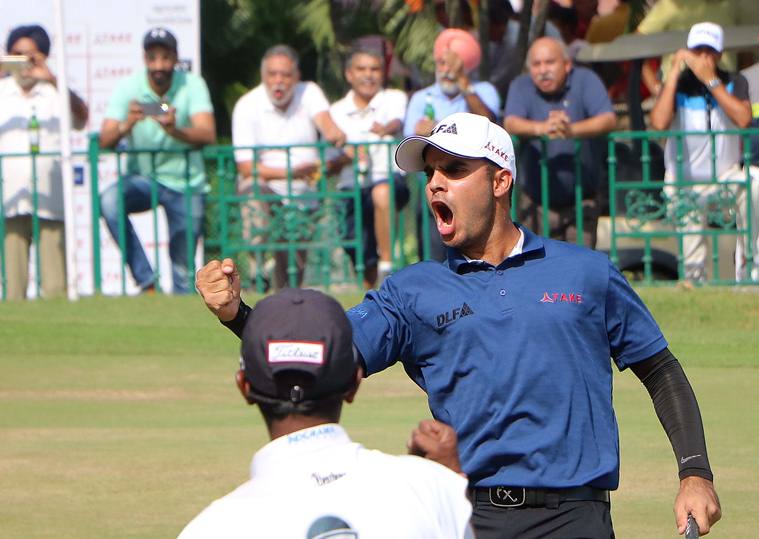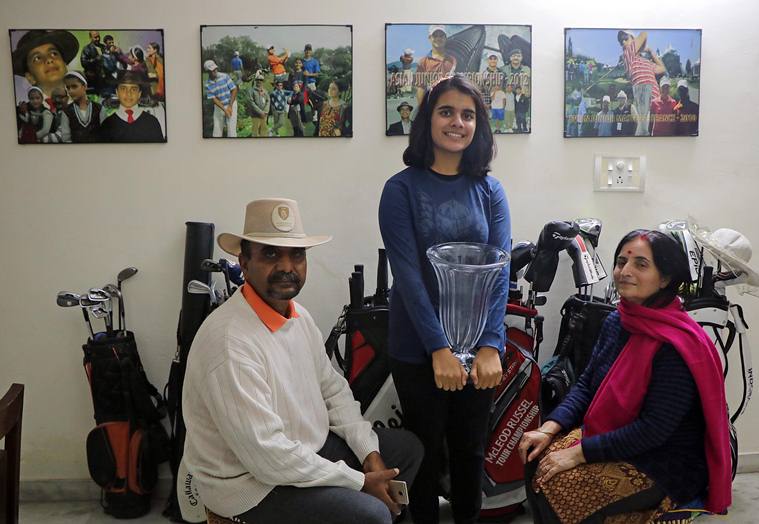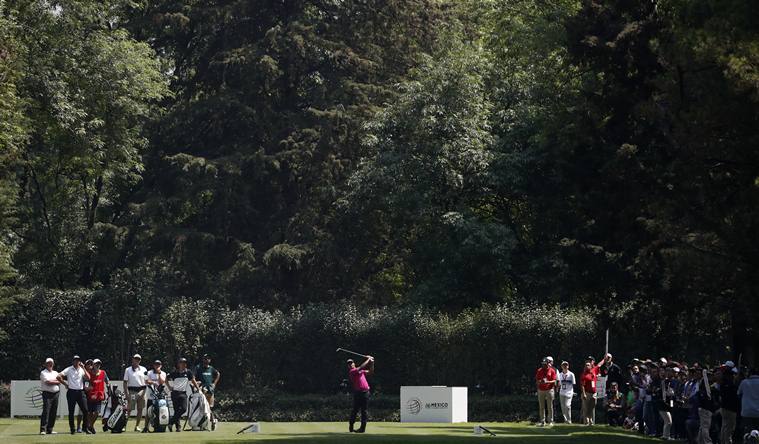 Shubhankar Sharma has caused waves on a global scale with his performance at the World Golf Championship. (Source: Express Photo by Sahil Walia)
Shubhankar Sharma has caused waves on a global scale with his performance at the World Golf Championship. (Source: Express Photo by Sahil Walia)
The most heartwarming story in Indian golf has an equally heartwarming back story. It goes back to a cool January afternoon in the year 2002 in Wellington, a self-contained military establishment in the Nilgiris, when Shubhankar Sharma’s mother Neena, pregnant with her second child, went into early labour. His father Mohan Lal Sharma, an Army colonel, was away on official duty. Alone at home with his mother screaming in pain, Shubhankar, only five years old then, did not panic. He sprinted to a nursing home roughly 200 metres away to call a doctor.
With no doctor available, Shubhankar arranged an ambulance and escorted his mother to a maternity home 5 km away. “The five-year-old boy admitted his mother to a hospital all by himself. When I reached the hospital at around 10.30 pm, Shubhankar was sleeping on the bed next to Neena,” Sharma, now retired, recalls.
It was a complex delivery. Shubhankar’s mother had high blood pressure and had gone into labour a month before the due date. “(But) there was this man called Dr (Tushar) Lahiri. He supported her through it and revived her,” says Sharma, 51.
Over the next few weeks, the two families bonded. Lahiri, an Army physician, couldn’t stop talking about the rapid strides his son Anirban, a promising junior, was taking on the golf course, while Neena and Sharma would not miss a chance to retell the story of their child’s presence of mind.
As a father of a prodigious golfer, Lahiri knew the importance of the trait in the sport. “So he told me, ‘Why don’t you put your son in golf? He’ll be very happy. You’ll realise that if you take him to golf,’” says Sharma.
The Sharma household had always wanted Shubhankar to play a sport. Initially, it was a toss-up between cricket and basketball — no one in their family had ever played golf. But they trusted Lahiri’s advice. In the beginning, Shubhankar would tag along with his father. Then, two months later, he got his first golf club. It was an unusual initiation. Little did they know back then that it would change everything for them.
***
 In the last four months, Shubhankar has won two international tournaments. (Source: Express Photo by Kamleshwar Singh)
In the last four months, Shubhankar has won two international tournaments. (Source: Express Photo by Kamleshwar Singh)
A fortnight ago, Shubhankar, now 21, overtook Anirban as India’s top-ranked golfer. That bit, however, dwarfs in comparison to the storm he’s been brewing across the globe.
In the last four months, Shubhankar has won two international tournaments. Earlier in March, he was the leader at the World Golf Championship going into the final round, something no Indian had ever managed before. These performances parachuted his world ranking from 462 in December 2017 to 69 at present, making him the youngest player in the world top-100. He also sits pretty high on the ranking charts of the European Tour, the second-most important tour in men’s golf after the PGA Tour, ahead of more established stars like former world number 1 Rory McIlroy.
All this has created a global hype around Shubhankar that’s rare for an Indian golfer. And it’s not just the results that have got everyone excited. Rather, it’s the manner in which he’s achieved them. Shubhankar has been bold and creative in his shot-making and has recorded really low scores rather nonchalantly, a pointer to his skill and mental strength. His extraversion makes him a popular figure among the players in a lonely, isolated sport like golf. And then, of course, there is the age.
Indians tend to turn professional in their early or mid-20s. “Whereas he is already winning titles at 21,” Jeev Milkha Singh, one of India’s most successful golfers, says of Shubhankar, who is competing in the US right now. “I turned professional at his age! This kid is special.”
So special, in fact, that earlier last month the organisers of Augusta Masters extended him a special invite — for the first time since 2013. The Masters is to golf what Wimbledon is to tennis or All England Championship is to badminton. It’s a rare privilege — a special invite is reserved for players who do not have easy access to the qualification process for the most prestigious event on the golfing calendar.
When he tees off on April 5, Shubhankar will become only the fourth Indian to compete at the fabled course and only the second to receive the special invite. Jeev, also his mentor, received one in 2008. “Throughout our history, we have extended invitations to deserving international players not otherwise qualified,” Augusta National chairman Fred Ridley had said while extending the invite. “As his results have proven, Shubhankar Sharma is a remarkable young player.”
His sudden ascent might have come as a surprise to the golfing world but those who have followed him back home knew it was only a matter of time before he would take off. “This is just the beginning. He’s going to surprise a lot of people,” Jesse Grewal, Shubhankar’s coach, predicts.
Shubhankar was just nine years old when Grewal took him under his wings at the Chandigarh golf range. At the time, Sharma was posted in Gurgaon, where he was informed about the superior facilities in Chandigarh by a few regulars at a local golf club. Almost overnight, the family relocated and got in touch with Grewal, who specialised in coaching junior players. What had started as a recreational activity in Wellington was now turning into a full-blown obsession. “By 2004, he had become a regular on the course and in 2007 or 2008, when he was 11 or 12, he had decided he would do this for rest of his life,” says Sharma.
But chasing a golfing dream comes at its own expense, which the Sharmas would quickly realise. Being in the army helped Sharma, who took an early retirement in 2012, get access to golf courses across the country. However, the cost of equipment and other expenses continued to drain them financially. “When I retired from service after 25 years, my savings amounted to less than Rs 1 lakh,” he says. “We don’t even have our own flat. It was never a priority for us. Our whole idea was, as long as he is playing, we need nothing.” Even today, the family stays in a rented accommodation in Chandigarh and could afford a new car only in 2009 — till then, they used second-hand vehicles. “Whatever (money) we had went in Shubhankar’s golf. It became our life’s mission,” says Sharma.
 Shubhankar Sharma’s family at their Panchkula residence. His father (left) says that Shubhankar would have been in IIT if he were not playing golf. (Source: Express Photo by Kamleshwar Singh)
Shubhankar Sharma’s family at their Panchkula residence. His father (left) says that Shubhankar would have been in IIT if he were not playing golf. (Source: Express Photo by Kamleshwar Singh)
Shubhankar, his father says, was also above-average in studies (“If not for golf, he’d been in IIT,” he says with more than a touch of pride). But once it was decided that their child would make a career in golf, the parents decided to discontinue conventional schooling. So, after Class X, Shubhankar was enrolled in an open school, which helped him focus completely on golf. By then, he was already rated among country’s top junior golfers. “Shubhankar was an aggressive golfer from childhood and had this belief in himself that if ‘he can do it, I can do it too.’ So he wasn’t afraid of taking on bigger players — age and stature wise,” Grewal says.
The only “distraction” was football. If he wasn’t watching golf, Shubhankar would be up late in the night watching Barcelona play while his mother stressed on yoga and meditation – something he relies on even now. “I was brought up in a religious household and the presence of God in our home was always strong,” Shubhankar had written in a blog on the European Tour website in February. “It’s from that I began meditating which I do from time to time, usually on planes when I’m alone. This allows me to recalibrate and to stay very grounded – an attribute my mother is very strong on…”
Grewal, meanwhile, honed the teenage golfing prodigy’s skills and Jeev — who practised at the same range — would chip in with occasional advice. In 2013, when he was 16, Shubhankar won the Indian Amateur Championship and was the country’s number one-ranked junior. Not having a golf background, in this case, helped as the family did not over-think their decisions or follow the herd.
Instead of hanging around and easing themselves into the professional circuit — something that most Indians do — Shubhankar was thrown into the deep end directly. “We thought what next? New targets were needed, so without wasting time playing among amateurs, we decided to make him go professional and compete with the big boys,” says Mohan Lal.
Soon, Shubhankar started beating them, too. In 2014, he became the youngest winner (aged 17 years, 8 months) on the Indian circuit when he clinched the Cochin Masters. The lead-up had been great, too, with top-10 finishes becoming routine. The boy was setting golf courses across the country on fire, and he wasn’t even old enough to drive yet. “At that moment, we realised he was destined for bigger things. He had to be playing the Majors and be on the PGA Tour,” Grewal says.
***
The PGA Tour is the toughest circuit in professional golf. Its tournaments are held in America and they attract all the top players from the world. They say you haven’t really made it as a golfer if you do not make it to the PGA Tour. For Indians, it’s the El Dorado – a monster that is as fascinating as it is intimidating. Only a handful of Indians have made it to the other side of the hemisphere and Arjun Atwal is the only player from the country to have won there.
Playing in America comes with some natural disadvantages if you’re an Indian, accessibility being the key. Since most golfers are self-funded, flying in and out of the USA for every tournament makes it financially unviable. For a full season, a player needs around $40,000-50,000 to just survive on the PGA Tour – and that’s a very conservative estimate.
The career of Rahil Gangjee, who was one of India’s most promising players around the time Shubhankar turned pro, hit a bunker as he tried to tame the challenging American courses. Gangjee qualified for the Web.com tour, the other equally competitive circuit in the US, in 2012, but by the end of the season, his expenses outweighed his income and he eventually ran out of money. “The weight (of playing there) can crush you,” he had said in an interview in March 2013. “Thinking of that stint even makes me go weak in my knees. It was like hitting rock bottom.”
Because there is absolutely no government support financially, stories like Gangjee’s are far too common for an Indian golfer playing abroad as private sponsors are hard to come by. Shubhankar knew that before he could harbour any hopes of playing in the US without the pressures that his predecessors faced, he’d first need to break the inhibitions and get proper backing. He’s been promised that and like most things in his career, this, too, came in a rather unconventional manner: via a one-of-a-kind road trip in 2015.
***
Gurbaaz Mann, 35, knows only too well the trials and tribulations that an Indian golfer has to face in the USA. He’d dreamt of competing as a pro on the PGA Tour, but, like Gangjee, he, too, had to return because of financial pressures. “There’s always this pressure at a subconscious level to do well so that you can just survive out there,” Mann says. “Every week is going to cost you roughly $3,000 – including your stay, food, caddie fees, etc. So you need to have the resources first.”
In late 2014, he formed the Indian American Professional Golfers Association (IAPGA) to help create a network for players, which makes playing on the PGA and Web.com Tours relatively easier. In 2015, Mann chose 10 young professional players from India, including Shubhankar, and flew them to New York with the intention of introducing them to the Indian community there and play on some of the golf courses to give them a feel of what awaits them.
They hired a 15-seater van, chucked their golf bags into the boot and embarked on a trip across the US that, Mann jokes, “even an American wouldn’t have taken.” They started on the East Coast, travelled to the West and back, while stopping just to play golf and reach out to the Indian community. “We travelled through 22 cities and stopped over in 15. We had fundraisers in five or six of them, did community outreach in some others, while we played a round of Pro-Am golf in a few cities,” Mann says. “In 45 days, we covered a distance that’s almost like driving from Delhi to New York and half-way back.”
The expense golfers incurred initially, Mann says, was purchasing the air tickets from India to New York while he forked out $7,000 from his pocket. By the time they finished their trip, they had raised $40,000, which was ultimately spent on their travel. “But what we managed was to create a network. If an Indian golfer comes to the US, he does not have to worry now about his stay or food. That is taken care of,” Mann says.
The trip helped Shubhankar gain confidence about playing in the US. The mental barrier, Mann says, was broken. “When you land in America, you realise how big that place is and how small you are. We played at some of the top golf courses and that opened up his mind. He knows that going to America and playing on the tour isn’t that tough.”
***
 In a field that comprised 45 out of the world’s top 50 players, Shubhankar took the least number of shots in Mexico City to complete the 54 holes divided equally over three rounds. (Source: AP)
In a field that comprised 45 out of the world’s top 50 players, Shubhankar took the least number of shots in Mexico City to complete the 54 holes divided equally over three rounds. (Source: AP)
Just how helpful that trip proved to was evident earlier this month at the World Golf Championship in Mexico City. In a field that comprised 45 out of the world’s top 50 players, Shubhankar took the least number of shots to complete the 54 holes divided equally over three rounds. Mann, incidentally, was his caddie during the tournament.
His performance in the third round, where he held on to his overnight lead despite being put under incredible pressure by some of the game’s heavyweights, is seen as one of the finest by an Indian in recent history. And even though he had won two big titles before this — in Johannesburg and Kuala Lumpur (which made him the youngest Indian to win two European Tour titles) — his third round display in Mexico made the world take notice of the young sensation.
Suddenly, commentators started talking about an Indian golfer — otherwise just another name on the crowded scoreboard — as someone in a position to “pull off the greatest upset in recent golf history”. “He (Shubhankar) will go into a Saturday night which will be unlike any other in his young 21 years on this planet, because there is going to be a lot to think about what could happen,” NBC’s old golf voice Dan Hicks noted in his closing remarks that evening.
Hicks’ words turned out to be prophetic, for sleep was the last thing on Shubhankar’s mind that night. At around 3am, he bolted upright in his bed and found his father, who was accompanying him, unable to sleep as well. “I had to tell him many times to take some rest but he was too excited that night,” says Sharma.
Shubhankar, alas, could not script history. The pressure, the occasion and the quality of competitors were too much for the 21-year-old to handle. But he did manage a top-10 finish — tied 9th, a highly-credible position in a world-class field. The Shubhankar wave that began in Mexico continued all the way till Gurgaon, where a higher-than-usual number of people turned up to watch the latest Indian sensation at his home course.
Shubhankar justified the hype once again by setting a course record in the second round. After a couple of weeks in India, he’s back in the US again — playing the World Match Play Championship in Texas this week before heading to Georgia for the year’s first major — the Augusta Masters.
His peers believe he is on the cusp of something bigger. “It’s been good to see that he’s not been overwhelmed or overawed by his success. He doesn’t care about the consequences or magnitude of a win,” Anirban Lahiri said at the Indian Open. Jeev adds: “His game is 70 per cent mental strength and 30 per cent on technique. He can take on the world. The kid has got it.” His father, though, can think of just one explanation: “The kid took his mother to a hospital as a 5-year-old all by himself. How can he not be strong mentally?”